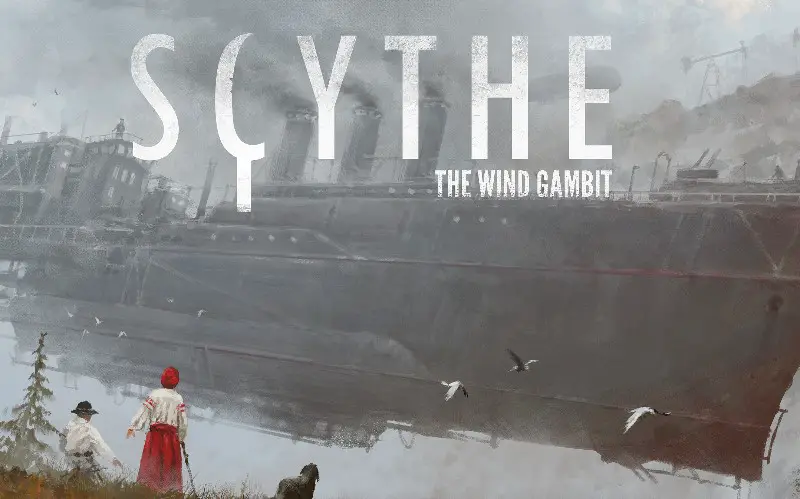
Mankind has long been confined to travel by land and sea, but a new technology has emerged from the greatest minds in Eastern Europa: airships. These steam-driven behemoths sail freely across the sky, aiding their empire's expansion through innovation and confrontation.
As the years pass, the world has come to understand that no single faction will rise above the rest for any span of time. In the hopes of decreasing the conflict and increasing the peace, leaders of Europa begin to gather each year to declare a new way for the factions to resolve their differences.
This expansion to Scythe adds 2 new modules that can be played together or separately at any player count and with either the base game or other Scythe expansions. These modules offer more strategic options without requiring players to use them.
We recommend that new players try the core game of Scythe before incorporating this expansion.

Airship Module
An airship is a new type of unit that is distinctly different from characters, mechs, and workers. Unlike those units, airships never control territories. Airships are moved via a Move action, and rivers and lakes do not constrain their movement. Each game, all airships have two randomly combined abilities that are the same for all players.
Setup
Each player claims the airship in their faction's color and places it on their home base.
Shuffle the 2 types of airship tiles separately (they have different backs). Reveal 1 aggressive tile (red) and 1 passive (green). Place the selected tiles on the board next to the encounter deck. All players' airships have a combination of both abilities at all times.
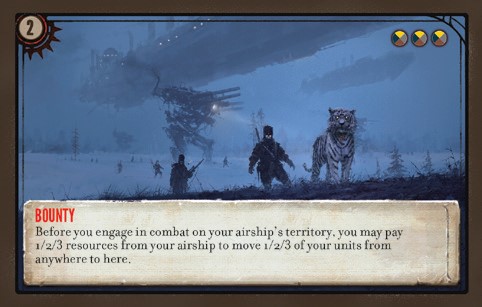

Territorial Control
Airships never control territories, thus they can fly freely onto any territory (even territories controlled by opponents).
Spending Resources: Airships cannot control territories. So unless you control a territory some other way, if there are resources on your airship's territory, you cannot spend those resources.
End-of-Game Territorial Control: When alone on a territory at the end of a game, an airship does not control the territory (nor the resources on that territory).
Transporting Resources Or Workers
Each aggressive airship tile features the ability to transport either up to 3 resources or up to 2 workers. This ability is constant-it applies to all airships, even if the written ability isn't being used.
This operates the same as how other units in the game can pick up and drop off resources (or how mechs transport workers): before, during, or after movement-it's always part of the Move action. The exception is that the tokens are placed on the airship miniature. Airships can't pick up resources from territories controlled by opponents.
Transporting Resources

Resources remain under your control on the airship until you spend them or choose to drop them on a territory (which you can do at any time while moving the airship).
Resources on your airship count during end-game scoring.
Airships may not pick up resources controlled by opponents.
Transporting Workers
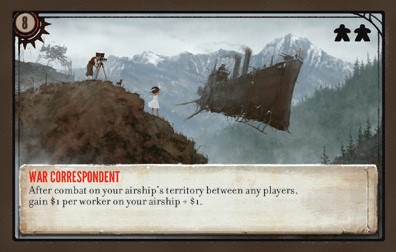
A worker on an airship does not give you control of the airship's territory- those workers can't produce or trade on that territory, nor can opponents interact with those workers. In addition:
Dropping Off Workers: Workers can only be dropped off on territories unoccupied by opponents. An airship must drop off a worker during its own move action before the worker can move or be carried by a mech in a subsequent move action (can be the same turn). Workers can't move directly from the airship to another territory.
Workers Transporting Resources: A worker picked up by an airship cannot transport resources onto the airship.
Albion (Rally Ability): Albion can only use its Rally ability to move to a territory with Albion workers (or a Flag)- the worker must be on the territory, not on an Airship.
Movement
Like all units in Scythe, to move your airship, select the Move action and choose the airship as one of the units to move.
Core Rules

Range: When moving your airship, you may move it up to the number of territories as indicated in the hex on the upper right of the passive airship tile (the "range"; this is the distance a unit can move). Remember that the standard movement rules in Scythe dictate that you must complete a unit's movement before moving another unit.
Rivers and Lakes: Airships are not constrained by rivers or lakes.
Airships on opponent-controlled territories: Airships can move freely onto and off of any territory (even territories controlled by opponents).
Multiple airships on the same territory: Any number of airships can be on the same territory.
Other Notes
Mech Abilities: Airships do not benefit from mech abilities- they are not mechs or characters.
Occupied/Unoccupied: These terms, which are used on several airship tiles, refer to the presence of units (or the lack thereof). If a territory has at least 1 unit (a worker, a character, or a mech) on it, it is "occupied".
FACTORY CARD: If you choose to use the Move action of a Factory card for your airship, the airship's range is increased by +1.
Home Base: Airships may not move onto home bases.
Tunnels and Mines: Airships may not move through tunnels or mines.
Combat: Having an airship on a combat territory does not increase the number of combat cards you may play.
Traps: Airships do not trigger Traps (a mechanism in Invaders from Afar).
Blitzkrieg: This aggressive ability allows combat to happen between 2 airships. The winner gains a star as usual. It is the only time an airship can retreat (other units on the territory do not engage or retreat).
Advanced Variant
Instead of all airships sharing the same two abilities, deal 1 aggressive airship tile and 1 passive airship tile to each player. The combination of those abilities applies only to each player's airship.
We generally recommend against doing this, particularly in games with 4+ players, as it's a lot of information to keep track of.
Resolution Module
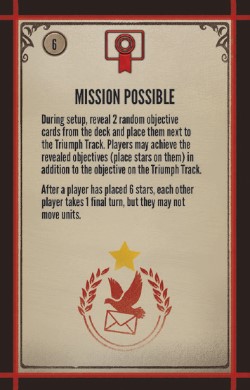
The resolution module changes the way a game of Scythe ends. If you play with this module, ignore the standard end-game trigger (when a player places their 6th star, everything stops and the game ends). Instead, the resolution tile for the current game will determine when and how the game ends.
Setup: Shuffle the resolution tiles, randomly select 1 tile, read it out loud, and place it face-up near the Triumph Track. This resolution tile applies to all players for the current game.
Stars: Some resolution tiles allow players to place stars on the tiles, on objective cards, etc-these still count for endgame scoring as if they are on the Triumph Track. You can never place more than 6 stars. However, it is now possible, with certain resolution tiles, for multiple players to have 6 stars.
Taking Actions for coins: This is in the original rulebook, but it is particularly applicable with the resolution module.
Even after you "complete" a bottom-row action (e.g., you've deployed all 4 of your mechs), on future turns when you choose that section of the player mat, you may still pay the cost of the bottom-row action to gain the coin benefit (and the recruit ongoing bonus, if applicable). You may not take any action more than once per turn.
Note: You may find that there is a certain resolution tile that meshes with your gaming group more than any other. If so, you can choose that tile every game instead of randomly selecting one.
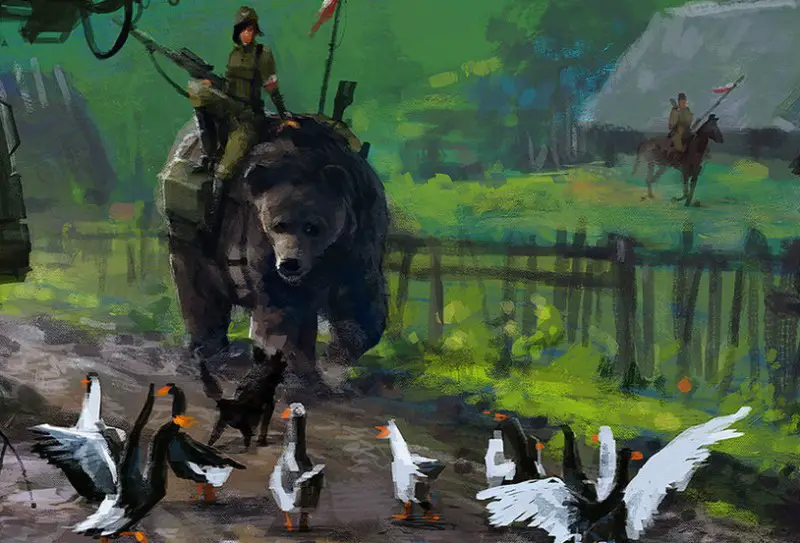
Errata And Variants
Scythe has some minor errata and a few recommended variants that you may not be familiar with. This information and more is available on the Stonemaier Games website (stonemaiergames.com/games/scythe/faq-scythe/), but here's a quick recap:
Forcing Workers To Retreat
The first two sentences on the right column of page 11 in the core-game rules (Moving into Opponent-Controlled Territories/Controlled by Workers) should read, "If your character or mech move into a territory controlled by an opponent's workers (and no other units), its movement ends (even if you have a mech ability that would allow it to move further). Each of the opponent's workers on that territory immediately retreats to their faction's home base, leaving behind any resource tokens".
This reflects the original intention of the rule, which allows a player to move a character/mech into a territory containing opponent worker(s), force those worker(_) to retreat, and then move a different unit through that territory.
Completing Objective Cards
There was some ambiguity in the original rules about exactly when on your turn you could complete an objective. Usually the timing doesn't matter, but for a few cards it does. So we clarified the timing as follows: "You may reveal a completed objective card during your own turn before or after you complete a top- or bottom-row action". Basically, you can't complete an objective in the middle of an action.
Rusviet Variant
You may have noticed that the Rusviet faction is pretty powerful. Our extensive blind playtesting process did not reveal them to be overpowered, but your experience may be different. If so, we recommend that the Rusviet faction ability of sequential turns with repeated actions cannot be used on a Factory card (particularly in 2-3 player games where the encounter-per-player ratio is higher). Also, the Rusviet faction should never be paired with the Industrial player mat.
Player Mat Order Variant
The starting resources on the player mats are staggered based on two factors (both of which have a very minor impact on the game): One, player order. Two, the playtest data for each individual mat (which shifted around in terms of numerical order during playtesting). So even if the #5 mat is in the second position in clockwise order, part of the balance of that mat's starting resources is that the #5 player mat appeared to be ever so slightly weaker than the others during the blind playtest process.
Overall, though, the impact on the game is very, very small.
However, if it better suits your group, you may deal out the mats clockwise by number.
Continue Reading

